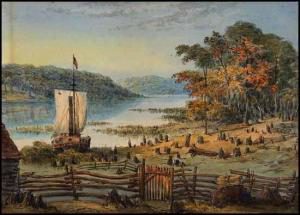On April 26, 1819, the Executive Council of Upper Canada issued an order in council promising free land to any citizens willing and able to settle along the strategic road linking the military outpost at Penetanguishene with the capital at York via Lake Simcoe. The order created one of the first pioneer settlements in Simcoe County.
The origins of the Penetanguishene Road began in 1793, when John Graves Simcoe, Upper Canada’s first lieutenant-governor, visited southern Georgian Bay and chose Penetanguishene as an ideal military harbour on the upper Great Lakes. The harbour was acquired by the province from the Ojibwa in 1798.
In March 1808, government surveyor Samuel Wilmot was sent to explore the land between Penetanguishene and Kempenfeldt Bay. In 1811, he returned to the area to survey the route of a road connecting Kempenfeldt Bay with Penetanguishene Harbour, as well as one concession of 200-acre lots on each side of the road and the outlines of a town plot at either end. The northern town site would eventually become the town of Penetanguishene. The southern one would become the village of Kempenfeldt, now a part of Barrie.
In the fall of 1814, after the Americans had almost severed British supply lines across Lake Huron, Lieutenant-Governor Sir Gordon Drummond and Sir George Prevost, commander in chief of British North America, ordered that an outpost be established at Penetanguishene. That December a party of Canadian soldiers and militiamen was dispatched to the area to begin constructing the outpost and the road surveyed by Wilmot in 1811. By February, when British soldiers arrived to help, only a few huts had been constructed at the outpost and the Penetanguishene Road was little more than an uneven trail pocked by stumps and made impassable when spring rain and melting snow turned it into a river of mud.
That March, news arrived that the war with the United States had ended. Construction of the outpost at Penetanguishene was halted and the site was quickly abandoned in favour of a fort on the Nottawasaga River. In 1818, the government relocated its upper Great Lakes post back to Penetanguishene and both the fort and the road came back in to use, although it can be imagined that after several years of disuse the already poor condition of the Penetanguishene Road had become even worse.
The order in council of April 1819 was meant to help improve the poor condition of the road and to develop the surrounding area. Settlers were offered grants of 200 acres along the road on condition that they quickly build a house, clear ten acres next to the road, and improve one half of the road fronting on their lots.
Notice of the settlement order was published in the York Gazette and within a few years about twenty families had settled along the road, mostly in its southern half.
Travellers from York to Penetanguishene in the early years of settlement would first see the log barracks and warehouse of the government station at Kempenfeldt as they neared the southern end of the Penetanguishene Road from across Lake Simcoe.
As they stepped onto the shore and began their journey up the road, travellers would pass by small groups of three or four or even six farms, each separated by a mile or two of wilderness.
Twelve miles or so up the road, about a day’s journey by wagon, travellers would come to the farm of Black Canadian settler William Davenport, the last farm they would see for another eleven miles.
Eventually travellers would pass a couple of solitary homesteads, separated by another mile of wilderness, before re-entering the forest. After another three or four miles, the travellers would finally see the village of Penetanguishene, where a few families had settled along the shores of the harbour in the year or two since the military post was revived.
The outpost itself lay behind a palisade another mile or so further along the shore, toward the mouth of the harbour. Like the nearby village, it remained a pretty modest affair until 1828, when the outpost at Drummond Island was shut down and its residents were relocated to Penetanguishene.
During the early years of settlement, most of the Penetanguishene Road settlers were preoccupied with clearing the land, establishing their farms, and completing their settlement duties in order to obtain full title to their property. For the most part, the only other people they saw were those travelling up or down the road: First Nations people, fur traders, soldiers, merchants, and the occasional missionary.
The settlements along the Penetanguishene Road were among the first in Simcoe County. Over the following years, the efforts of the Penetanguishene Road settlers would improve the road, clear the surrounding land, and establish the first stores, villages, churches and township councils, opening the area up for further settlement and beginning the transformation of the land to the way it looks today.
Photo: George Russell Dartnell, view of Penetanguishene Harbour from his farm, ca. 1836.
